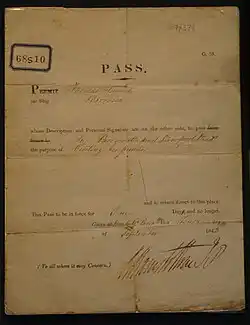
Australian tickets of leave were papers which were issued to convicts in Australia in the nineteenth century which granted additional freedoms to prisoners while they served out their sentences. There were 162,000 convicts sent from Britain and Ireland to Australia, Tasmania and other island prisons near Australia between 1788 and 1868. These were usually sentenced to terms of seven or fourteen years. Many were dispatched to the southern hemisphere for rather minor crimes. As such they didn’t pose a threat to public safety and after a year or two they were often issued with ‘tickets of leave’ which allowed them to look for paid work and also provided other liberties such as the right to marry. First introduced informally in the first years of the nineteenth century, the system was formalized in 1824 and lasted down to 1874. The tickets of leave are an excellent source for tracing one’s ancestors in Australia and the reasons why they were sent there and when they were given increased freedoms.[1]
Research your ancestors on MyHeritage
Australian tickets of leave chronology of eventsAustralian tickets of leave chronology of events
British settlement in Australia began in the late eighteenth century when numerous fleets carrying thousands of British and Irish convicts arrived to New South Wales and other regions to establish penal colonies on the continent. Between the arrival of the First Fleet to Botany Bay in 1788 and the final termination of the penal transport system in 1868 some 162,000 convicts were transported from Britain and Ireland to Australia and other British colonies on Norfolk Island and Tasmania. There the convicts were destined to serve either seven or fourteen year spells of penal labor. The terms were often disproportionate, with severe crimes punishable by fourteen years and relatively minor misdemeanors leading to a seven year sentence.[2]
The expectation with this penal system was that the years of hard labor would serve to partially ‘reform’ those sent to Australia. They would then in all likelihood remain there, as to try to return to Europe in an age before the proliferation of the steam-ships and without financial ability would prove very difficult, if not altogether impossible. As a result, the government perceived that the former convicts would become productive members of the growing British colonies in Australia and Tasmania. To this end, in the early 1800s the colonial government in New South Wales began issuing ‘tickets of leave’ on an informal basis.
These were tickets that granted a convict a large amount of personal freedom. He or she could try to obtain work outside of the penal system and in some cases their own place to live. They were required to carry their tickets with them for inspection and also to engage in activities such as attending religious services which were deemed conducive towards their ‘moral improvement’. Effectively this was an early parole system. The benefits for the colonial government were that they did not have to continue paying to house and support a convict, while in many instances those who were granted tickets of leave had been sent to Australia for very minor crimes (theft of a chicken and the like) and did not pose a danger to the wider community if given additional freedoms.[3]
The tickets of leave system was extended in the early 1820s and was formalized in 1824. It was in place for half a century thereafter, only being discontinued in 1874, six years after the last penal transport ship arrived to Australia. The tickets themselves were a physical document much like a passport or identity card. They gave essential details like the convict’s name, year and place of birth, the crime which they had been convicted of, the date of their arrival in Australia and the length of their sentence. Information on what the convict was allowed to do or was prohibited from doing (i.e. what liberties had been granted to them) was also given.[4] Because the tickets were issued in a period when the first daguerreotype cameras had either still not been invented or were not widely available, photos were not provided as would be the case with modern passports and identity cards. Instead details of the physical attributes of the prisoner were sometimes provided on the ticket such as their hair color, eye color, height and details of any other distinguishing physical features.[5]
Extent of migration associated with tickets of leaveExtent of migration associated with tickets of leave
The tickets of leave did not on the surface lead to any migration. The convicts that they were issued to were already present in Australia for other reasons when they were issued. What they did do was increase the possibility of former convicts remaining once their sentence had been served. Through the tickets individuals were able to lay down roots in the community of New South Wales and the other colonies while they were still prohibited from leaving. For instance, not only could a convict acquire a job and a home once a ticket of leave was issued, they could also marry or have their family from back in Britain or Ireland join them if they were already married. Consequently, the ticket of leave system made it much more likely that penal migrants to Australia would remain there once their sentence had been served.[6]
Demographic impact of the tickets of leaveDemographic impact of the tickets of leave

The demographic impact of the system of tickets of leave was substantial. The overwhelming majority of convicts chose to remain in Australia once their penal terms had been served. As a result, it is estimated that upwards of 20% of Australia’s 25 million people, or some five million Australians, are descended to one degree or another from the 162,000 penal convicts sent to the southern continent between 1788 and 1868. Take the example of Mary Wade, the youngest ever convict sent to Australia. She was arrested and sentenced to death in 1789 in England for stealing a few items of clothing. Her brutally excessive sentence was quickly commuted and she was sent to Australia at 11 years of age as part of the Second Fleet. She went on to live a long life in Australia, starting a family there in the 1800s. By the time she died in 1859 in her eighties she had over 300 descendants, while today her descendants number well over 10,000 and include the Prime Minister of Australia from 2007 to 2010, Kevin Rudd.[7]
The tickets of leave are a valuable source of information for researchers looking to trace their ancestors in Australia. They provide extensive details on the prisoners involved and the specifics of when, how and why they were sent to Australia. Moreover, the tickets are especially useful in so far as they also provide details to researchers on what a family member might have looked like, information which is not provided in nineteenth-century census records. By using the information of the tickets of leave and British and Irish census records, researchers can develop a detailed picture of their Australian ancestors.[8]
See alsoSee also
Explore more about Australian Penal ColoniesExplore more about Australian Penal Colonies
- Australia, New South Wales Convicts Index, 1791-1873 record collection on MyHeritage
- Australia, New South Wales Birth Index, 1787-1916 record collection on MyHeritage
- Australia, New South Wales Death Index, 1787-1986 record collection on MyHeritage
- Settlers, Squatters and Selectors: Land ownership in Australia, 1788-1900 at Legacy Family Tree Webinars
- A Cargo of Criminals: Transportation to Australia at Legacy Family Tree Webinars
- Researching in Australian Archives at Legacy Family Tree Webinars
- Australia Day: January 26 at the MyHeritage blog
References
- ↑ https://www.nla.gov.au/research-guides/convicts/tickets-of-leave
- ↑ https://www.digitalpanopticon.org/Convicts_and_the_Colonisation_of_Australia,_1788-1868
- ↑ https://mhnsw.au/guides/convict-tickets-leave/
- ↑ https://researchdata.edu.au/nrs-12204-butts-leave-passports/178411
- ↑ https://www.bda-online.org.au/sources/tickets-of-leave/
- ↑ https://www.migrationmuseum.org/were-your-ancestors-transported-to-australia-as-convicts/
- ↑ https://convictrecords.com.au/convicts/wade/mary/66503
- ↑ https://www.nla.gov.au/research-guides/convicts/tickets-of-leave

